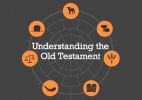Understanding the OT: it all makes sense with Jesus
Read our final article in the series, and get stuck into the Old Testament yourself.
I told you so...
Well, Ezekiel was right. Five years after he began to prophesy that Jerusalem would be destroyed for their sin, it happened. Around 587BC the people in that city decided to find out what happens when you stand up to King Nebuchadnezzar of Babylonia.
This is what happens: after an 18 month seige, the ones who weren’t killed, were forced to join Ezekiel in exile. Given that God had promised there would always be a son of David ruling on the throne in Jerusalem, the destruction of Jerusalem, and exile of the only Davidic king around, was a bit of a problem. Ezekiel was shattered, but he wasn’t surprised: it’s exactly what he said would happen, because his people had rebelled against God.
The valley of bones
In chapter 37 Ezekiel sees a not-so-subtle vision to represent this situation: a valley full of dead bones.
The hand of the LORD was upon me, and he brought me out by the Spirit of the LORD and set me in the middle of a valley; it was full of bones. He led me back and forth among them, and I saw a great many bones on the floor of the valley, bones that were very dry. (Ezekiel 37:1-2)
Imagine a whole nation had been hacked to pieces and left to rot. Metaphorically, this is how the Jews saw themselves: ‘Our bones are dried up and our hope is gone; we are cut off’ (Ezekiel 37:11).
The situation seemed hopeless. Judgment had been and gone, and it was too late to do anything about it. If you are dry bones, then it’s too late to quit smoking, go to the doctor, or start eating more healthily. So when God asks him ‘can these bones live?’, Ezekiel’s answer is that ‘only you know’. Humanly speaking, it wasn’t looking very promising.
God tells Ezekiel to prophesy to the bones. They hadn’t changed their ways when Ezekiel spoke to them before; what chance could there be now? (Maybe you’ve felt like this telling your friends about Jesus – have you ever felt it was hopeless, about as good as talking to a pile of bones?)
But when God is involved, no situation is hopeless. As Ezekiel starts prophesying, the bones come back to life.
So I prophesied as I was commanded. And as I was prophesying, there was a noise, a rattling sound, and the bones came together, bone to bone. (Ezekiel 37:7)
God is the one who gives life, and puts his Spirit into things to make them respond to him.
New life in the future
This vision was a metaphorical coming back to life. The bones represented the situation of God’s people. And the new life represented a hope that one day they would be brought back together into the land God had promised. And they were, about 50 years later, when the Persian empire took over from the Babylonian empire and were much more friendly to Jews. In 538BC the exile ended: something which must have seemed humanly impossible fifty years earlier! (It was a big improvement, but because of human sin things never quite got back to the way they hoped, leaving many to hope for the day when God himself would intervene and make everything perfect.)
Big Tip: Jesus re-interprets the Old Testament to explain who he is and what he’s doing.
When Jesus came he reinterpreted the whole Old Testament as referring to him (Luke 24:44). The key to reading the Old Testament as a Christian is to learn to make the links which Jesus makes, like the links between the temple and his body, between the promised Christ and himself.
One of the links Jesus made is that the gathering of his people in Jerusalem is now a heavenly gathering which you are a part of already if you are a Christian (Hebrews 12:22).
So for Christians, the resurrection of God’s people and regathering of them in Jerusalem becomes something even more impressive: the literal resurrection of a bunch of people from death. Jesus rose from the dead (John 20). All those who are in Christ, who belong to him, who call on the name of the Lord ... they are resurrected too. No matter how hopeless the situation is, they have life that cannot be taken away:
Very truly I tell you, whoever hears my word and believes him who sent me has eternal life and will not be judged but has crossed over from death to life. John 5:24
No matter how humanly hopeless a situation is, there is hope. People go looking for miracles – I see them every day, when someone comes into church, and hears the word of the Lord, and passes from death to life.
Keep reading the Old Testament
In this series, we’ve dipped into five short passages from Ezekiel. They’ve told us about who God is, what he’s doing about human sin, what humanity is like, and how Jesus understood what he was doing. Along the way we’ve picked up five tips for reading the Old Testament:
- Tip #1: get the background: the place, time and context
- Tip #2: when we meet the God of the Old Testament, we’re meeting the same God we worship
- Tip #3: find how the passage fits in the story of the God who saves sinners
- Tip #4: the Old Testament gives us wisdom about the world and humanity that still applies today
- Tip #5: Jesus re-interprets the Old Testament to explain who he is and what he’s doing
So with these tips in mind, have a go at reading another Old Testament book. I recommend starting with Genesis, Exodus, Judges or Isaiah. And if you can read along with a group, so you can help each other out.
Happy travels in the foreign land of the Old Testament!




